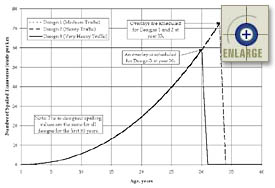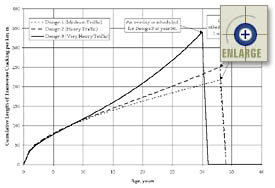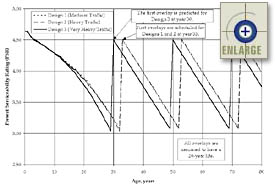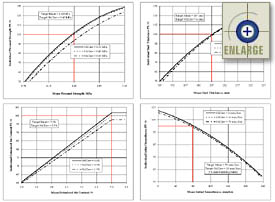U.S. Department of Transportation
Federal Highway Administration
1200 New Jersey Avenue, SE
Washington, DC 20590
202-366-4000
Federal Highway Administration Research and Technology
Coordinating, Developing, and Delivering Highway Transportation Innovations
 |
| This report is an archived publication and may contain dated technical, contact, and link information |
|
Publication Number: FHWA-RD-98-156 Date: FEBRUARY 1999 |
Introduction |
A second method used to demonstrate the Level 1 PRS prototype specification involved developing general pay factor charts for typical designs within a chosen SHA. As a follow-up to the original shadow field trial, the research team developed Level 1 pay factor charts representative of three typical pavement designs used in Iowa. The objectives of this exercise were twofold:
This chapter explains the details of selecting the different pavement designs, the development of the respective pay factor charts, an analysis of the observed trends within and between the developed charts, and the conclusions and recommendations resulting from this exercise.
The first step was the selection of three typical PCC pavement designs used in Iowa. Each pavement design was selected to be specific to an assumed traffic level representing medium, heavy, or very heavy traffic. All three pavement designs were assumed to have a 40-year design life. The chosen cumulative ESAL values (over the 40-year design lives) for each of the chosen traffic classifications consisted of the following:
For the development of these pay factor charts, pavement performance was defined in terms of all of the four available distress indicators (i.e., transverse slab cracking, transverse joint faulting, transverse joint spalling, and pavement smoothness over time).
For the three chosen typical designs, Level 1 pay factor charts were developed for each of the following four AQC’s:
The representative constant values required to simulate the corresponding pay factor charts (for the three chosen designs) were determined based on information provided by Iowa SHA personnel. Values for the climatic-related variables and unit costs were assumed to be the same as those used at the original PRS field trial conducted in Wapello County, Iowa, in 1996 (see chapter 2 of this volume). More information on the selection of constant variables is presented in chapter 5 of volume I, in the section titled Identification of Constant Variable Values. The specific values chosen to represent each of the three typical designs are presented in table 71. (Note: The constant inputs presented in table 71 are those required by the old distress prediction models used in the prototype PaveSpec software.(1-3) These variables differ slightly from those constant values required by the new distress indicator models included in the revised PaveSpec 2.0 software [as shown in figure 1 of volume I].)
|
Variable |
Design 1 (Medium Traffic) |
Design 2 (Heavy Traffic) |
Design 3 (Very Heavy Traffic) |
|
|---|---|---|---|---|
| Project Information | ||||
| Pavement Type |
Doweled, JPCP |
|||
| Road Location |
Rural Setting |
|||
| Highway Type |
Undivided |
Divided |
Divided |
|
| Design Life |
40 years |
|||
| No. of Lanes in One Direction |
1 |
2 |
2 |
|
| Lane Width |
3.7 m |
|||
| Joint Spacing |
6.1 m |
|||
| Traffic Information | ||||
| Total Design Traffic |
2.5 MESAL’s |
7.5 MESAL’s |
30.0 MESAL’s |
|
| Initial Year Traffic |
62,500 ESAL’s |
187,500 ESAL’s |
750,000 ESAL’s |
|
| Traffic Growth Type |
Simple Linear Trend |
|||
| Materials and Climatic Information | ||||
| Annual Temperature Range |
22 ºC |
|||
| Freezing Index |
750 degree-days |
|||
| Average Annual Precipitation |
81.3 cm |
|||
| Projected Annual Freeze-Thaw Cycles (at 7.6 cm below the pavement surface) |
12 |
|||
| Salt Present |
Yes |
|||
| Joint Sealant Type |
Liquid Asphalt |
|||
| Slab Support Information | ||||
| Base Type |
Granular |
|||
| Modulus of Subgrade Reaction |
40.7 MPa/m |
|||
| Subgrade Soil Type |
Fine-grained (AASHTO A4-A7) |
|||
| Presence of Longitudinal Subdrains |
Yes |
|||
| Load Transfer Information | ||||
| Dowel Bar Diameter |
3.2 cm |
3.8 cm |
3.8 cm |
|
| Presence of Tied PCC Shoulder |
Yes |
|||
| Cost Information | ||||
| Construction Bid, Traffic Lanes (based on $86.32/m3) |
$17.89/m2 |
$20.08/m2 |
$23.32/m2 |
|
| Cost of Asphalt Overlay |
$10.76/m2 |
|||
| Cost of Patching a Joint |
$95.68/m2 |
|||
| Cost of Replacing a Slab |
$83.72/m2 |
|||
| Assumed Asphalt Overlay Life |
20 years |
|||
Four different AQC’s were chosen to demonstrate the Level 1 PRS approach for each of the three typical designs. These included 28-day flexural strength (third-point loading), slab thickness, plastic entrained air content (using a pressure meter), and initial smoothness (measured using a 5.1-mm blanking band). The AQC target means and standard deviations for each of the three designs were estimated by interpreting the current Iowa construction specifications. These values were determined using the same procedures utilized in determining the target values at the original Iowa field trial in 1996 (see the section titled Definition of the Required As-Designed AQC Target Values in chapter 2 of this volume). The chosen AQC as-designed target means and standard deviations are presented in table 72 (the actual specification design thickness means are shown as a comparative reference).
Table 72. Chosen AQC as-designed target values for three typical pavement designs in Iowa.
|
AQC |
Design 1 (Medium Traffic) |
Design 2 (Heavy Traffic) |
Design 3 (Very Heavy Traffic) |
|
|---|---|---|---|---|
| 28-day Flexural Strength (third-point loading) | ||||
| PRS Target Mean |
4.48 MPa |
|||
| PRS Target Std Dev |
0.45 MPa |
|||
| Slab Thickness | ||||
| Specification Design Mean |
203 mm |
229 mm |
267 mm |
|
| PRS Target Mean |
207 mm |
233 mm |
271 mm |
|
| PRS Target Std Dev |
6 mm |
|||
| Entrained Air Content | ||||
| PRS Target Mean |
7.0% |
|||
| PRS Target Std Dev |
0.5% |
|||
| Initial Smoothness (5.1-mm blanking band) | ||||
| PRS Target Mean |
79 m/km |
|||
| PRS Target Std Dev |
16 mm/km |
|||
A number of simulation-related parameters are required to simulate LCC’s representing the as-designed and as-constructed pavement lots. The individual Level 1 AQC pay factor charts were simulated using the following simulation parameters:
These simulation parameters are used in conjunction with the defined constant variable values and selected AQC target values to generate the preconstruction output.
The final step in the specification development process involves the development of the preconstruction output. For the Level 1 specification, this involves constructing individual pay factor charts (and corresponding pay factor equations) for the four AQC’s. Individual AQC pay factors may be computed using these equations by knowing the as-constructed AQC lot means and standard deviations. (Note: Each pay factor chart is specific to the chosen constant values, target means, and standard deviations.)
Step-by-Step Procedure Used to Develop Individual Level 1 AQC Pay Factor Curves
The following step-by-step procedure was used to develop Level 1 pay factor charts and corresponding pay factor equations for the three typical Iowa designs. (Note: Each of these steps is accomplished using the PaveSpec PRS demonstration software.)
Table 73. As-constructed AQC simulation mean ranges for the three typical
|
AQC |
Design 1 (Medium Traffic) |
Design 2 (Heavy Traffic) |
Design 3 (Very Heavy Traffic) |
|---|---|---|---|
| 28-day Flexural Strength (third-point loading), MPa |
3.78 – 5.18 |
||
| Slab Thickness, mm |
187 – 227 |
213 – 253 |
251 – 291 |
| Entrained Air Content, % |
0.0 – 7.0 |
||
| Initial Smoothness (5.1-mm blanking band), mm/km |
0 – 240 |
||
Table 74. As-constructed AQC standard deviation levels for simulation
|
AQC |
Design 1 (Medium Traffic) |
Design 2 (Heavy Traffic) |
Design 3 (Very Heavy Traffic) |
|---|---|---|---|
| 28-day flexural strength (third-point loading), MPa |
0.00, 0.45, 0.90 |
||
| Slab thickness, mm |
0, 6, 13 |
||
| Entrained air content, % |
0.0, 0.5, 1.5 |
||
| Initial smoothness (5.1-mm blanking band), mm/km |
0, 16, 79 |
||
- Design 1 (Medium Traffic): LCCDES(1) = $668,709/km.
- Design 2 (Heavy Traffic): LCCDES(2) = $706,135/km.
- Design 3 (Very Heavy Traffic): LCCDES(3) = $722,795/km.
To better demonstrate the PRS method, the estimated typical distresses over time associated with each of the three Iowa designs (reflecting the chosen constant inputs and the AQC target means only) are presented in figure 14. These distresses reflect the predicted first overlay application at year 33 for Designs 1 and 2, and year 30 for design 3. The M & R plan defined for the original Iowa field trial was also used here.
| Figure 14. Estimated typical as-designed distresses over time associated with each of the three typical designs (reflecting the chosen constant inputs and the AQC target means only). |
 |
 |
 |
|
As-Constructed Means |
Simulated pay factors at different as-constructed standard deviations, % |
||
|---|---|---|---|
|
28-day Flexural Strength (third-point loading), MPa |
SD = 0.00 MPa |
SD = 0.45 MPa |
SD = 0.90 MPa |
|
3.78 |
48.6 |
47.3 |
43.4 |
|
4.48 |
101.3 |
100.0 |
93.4 |
|
5.18 |
128.8 |
127.9 |
123.8 |
|
Slab Thickness, mm |
SD = 0 mm |
SD = 6 mm |
SD = 13 mm |
|
187 |
49.8 |
48.8 |
46.6 |
|
207 |
99.2 |
100.0 |
98.1 |
|
227 |
126.9 |
127.2 |
126.6 |
|
Entrained Air Content, % |
SD = 0.0% |
SD = 0.5% |
SD = 1.5% |
|
2.0 |
67.4 |
66.8 |
66.0 |
|
7.0 |
101.8 |
100.0 |
97.5 |
|
Initial Smoothness (0.0-mm blanking band), mm/km |
SD = 0 mm/km |
SD = 16 mm/km |
SD = 79 mm/km |
|
0 |
112.5 |
112.5 |
110.8 |
|
79 |
100.6 |
100.0 |
99.2 |
|
240 |
58.6 |
58.2 |
57.3 |
|
As-Constructed Means |
Simulated pay factors at different as-constructed standard deviations, % |
||
|---|---|---|---|
|
28-day Flexural Strength (third-point loading), MPa |
SD = 0.00 MPa |
SD = 0.45 MPa |
SD = 0.90 MPa |
|
3.78 |
70.9 |
67.7 |
61.6 |
|
4.48 |
100.5 |
100.0 |
94.9 |
|
5.18 |
115.9 |
116.1 |
113.5 |
|
Slab Thickness, mm |
SD = 0 mm |
SD = 6 mm |
SD = 13 mm |
|
213 |
74.7 |
73.4 |
71.5 |
|
233 |
100.7 |
100.0 |
99.5 |
|
253 |
114.4 |
114.3 |
114.0 |
|
Entrained Air Content, % |
SD = 0.0% |
SD = 0.5% |
SD = 1.5% |
|
2.0 |
77.1 |
76.9 |
76.7 |
|
7.0 |
101.0 |
100.0 |
98.5 |
|
Initial Smoothness (0.0-mm blanking band), mm/km |
SD = 0 mm/km |
SD = 16 mm/km |
SD = 79 mm/km |
|
0 |
107.1 |
107.1 |
106.0 |
|
79 |
100.5 |
100.0 |
99.9 |
|
240 |
79.1 |
78.8 |
78.4 |
|
As-Constructed Means |
Simulated pay factors at different as-constructed standard deviations, % |
||
|---|---|---|---|
|
28-day Flexural Strength (third-point loading), MPa |
SD = 0.00 MPa |
SD = 0.45 MPa |
SD = 0.90 MPa |
|
3.78 |
74.1 |
72.3 |
67.7 |
|
4.48 |
101.7 |
100.0 |
93.6 |
|
5.18 |
119.0 |
118.1 |
114.0 |
|
Slab Thickness, mm |
SD = 0 mm |
SD = 6 mm |
SD = 13 mm |
|
251 |
79.1 |
78.7 |
76.7 |
|
271 |
100.7 |
100.0 |
99.2 |
|
291 |
116.4 |
116.0 |
115.8 |
|
Entrained Air Content, % |
SD = 0.0% |
SD = 0.5% |
SD = 1.5% |
|
2.0 |
85.4 |
84.6 |
83.8 |
|
7.0 |
100.6 |
100.0 |
99.1 |
|
Initial Smoothness (0.0-mm blanking band), mm/km |
SD = 0 mm/km |
SD = 16 mm/km |
SD = 79 mm/km |
|
0 |
106.6 |
105.2 |
103.4 |
|
79 |
100.4 |
100.0 |
99.3 |
|
240 |
84.9 |
84.6 |
84.2 |
 |
Figure 15. Design 1 (medium traffic)—simulated Level 1 individual AQC pay factor charts for the case of four sublots per lot and four samples per sublot (lot sample size N=16). |
 |
Figure 16. Design 2 (heavy traffic)—simulated Level 1 individual AQC pay factor charts for the case of four sublots per lot and four samples per sublot (lot sample size N=16). |
 |
Figure 17. Design 3 (very heavy traffic)—simulated Level 1 individual AQC pay factor charts for the case of four sublots per lot and four samples per sublot (lot sample size N=16). |
| AQC |
As-Constructed Standard Deviation |
Pay Factor Regression Equation, x = mean value |
|---|---|---|
| 28-day Flexural Strength (third-point loading) |
0.00 MPa |
PFS-(x, 0.00) = –25.7189x2 + 287.7179x – 671.4876 |
|
0.45 MPa |
PFS-(x, 0.45) = –25.3191x2 + 284.4695x – 666.2597 | |
|
0.90 MPa |
PFS-(x, 0.90) = –19.9880x2 + 236.5143x – 565.0175 | |
| Slab Thickness |
0 mm |
PFT-(x, 0) = –2.7195E-02x2 + 13.1846x – 1464.7132 |
|
6 mm |
PFT-(x, 6) = –2.8791E-02x2 + 13.8807x – 1540.1355 | |
|
13 mm |
PFT-(x, 13) = –2.8768E-02x2 + 13.9090x – 1548.3911 | |
| Plastic Entrained Air-Content (for 0 to 7% only) |
0.0% |
PFA-(x, 0.0) = 6.8683x + 53.6719 |
|
0.5% |
PFA-(x, 0.5) = 6.64x + 53.52 | |
|
1.5% |
PFA-(x, 1.5) = 6.315x + 53.335 | |
| Initial Smoothness |
0 mm/km |
PFSM-(x, 0) = –4.6066E-04x2 – 0.1139x + 112.45 |
|
16 mm/km |
PFSM-(x, 16) = –4.2248E-04x2 – 0.1246x + 112.48 | |
|
79 mm/km |
PFSM-(x, 79) = –4.7001E-04x2 – 0.1100x + 110.8 |
| AQC |
As-Constructed Standard Deviation |
Pay Factor Regression Equation, x = mean value |
|---|---|---|
| 28-day Flexural Strength (third-point loading) |
0.00 MPa |
PFS-(x, 0.00) = –14.5726x2 + 162.7450x – 336.0902 |
|
0.45 MPa |
PFS-(x, 0.45) = –16.5210x2 + 182.6422x – 386.6551 | |
|
0.90 MPa |
PFS-(x, 0.90) = –15.0809x2 + 172.2030x – 373.8903 | |
| Slab Thickness |
0 mm |
PFT-(x, 0) = –1.5438E-02x2 + 8.1861x – 968.5134 |
|
6 mm |
PFT-(x, 6) = –1.6236E-02x2 + 8.5896x – 1019.5902 | |
|
13 mm |
PFT-(x, 13) = –1.6794E-02x2 + 8.8875x – 1059.5914 | |
| Plastic Entrained Air-Content (for 0 to 7% only) |
0.0% |
PFA-(x, 0.0) = 4.7850x + 67.5050 |
|
0.5% |
PFA-(x, 0.5) = 4.6183x + 67.6719 | |
|
1.5% |
PFA-(x, 1.5) = 4.3700x + 67.9200 | |
| Initial Smoothness |
0 mm/km |
PFSM-(x, 0) = –2.0616E-04x2 – 0.0673x + 107.10 |
|
16 mm/km |
PFSM-(x, 16) = –1.7625E-04x2 – 0.0753x + 107.05 | |
|
79 mm/km |
PFSM-(x, 79) = –2.3768E-04x2 – 0.0579x + 105.95 |
Table 80. Design 3 (very heavy traffic)—Level 1 AQC best-fit regression equations for the case of four sublots per lot and four samples per sublot (lot sample size N=16).
| AQC |
As-Constructed Standard Deviation |
Pay Factor Regression Equation, x = mean value |
|---|---|---|
| 28-day Flexural Strength (third-point loading) |
0.00 MPa |
PFS-(x, 0.00) = –10.5255x2 + 126.3893x – 253.3085 |
|
0.45 MPa |
PFS-(x, 0.45) = –9.8374x2 + 120.8210x – 243.8380 | |
|
0.90 MPa |
PFS-(x, 0.90) = –5.4613x2 + 82.0068x – 164.2257 | |
| Slab Thickness |
0 mm |
PFT-(x, 0) = –7.4090E-03x2 + 4.9484x – 696.1730 |
|
6 mm |
PFT-(x, 6) = –7.2153E-03x2 + 4.8425x – 682.2020 | |
|
13 mm |
PFT-(x, 13) = –7.5020E-03x2 + 5.0440x – 716.7401 | |
| Plastic Entrained Air-Content (for 0 to 7% only) |
0.0% |
PFA-(x, 0.0) = 3.0383x + 79.3319 |
|
0.5% |
PFA-(x, 0.5) = 3.0733x + 78.4869 | |
|
1.5% |
PFA-(x, 1.5) = 3.0583x + 77.7019 | |
| Initial Smoothness |
0 mm/km |
PFSM-(x, 0) = –7.3172E-05x2 – 0.0727x + 106.60 |
|
16 mm/km |
PFSM-(x, 16) = –1.2338E-04x2 – 0.0561x + 105.20 | |
|
79 mm/km |
PFSM-(x, 79) = –1.7278E-04x2 – 0.0384x + 103.40 |